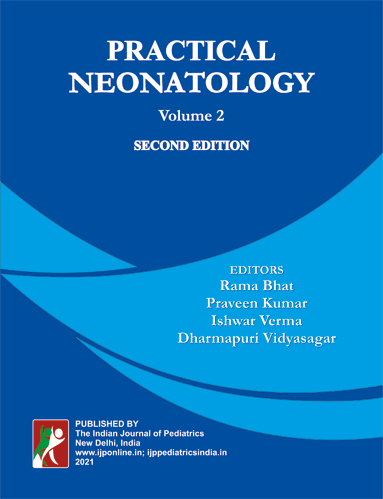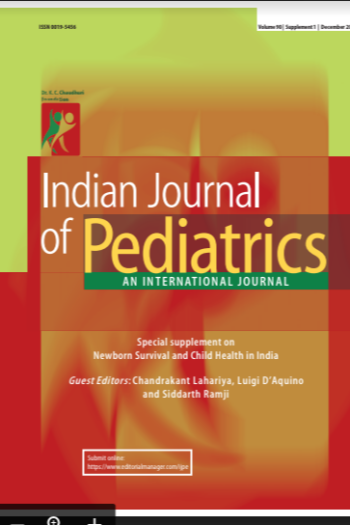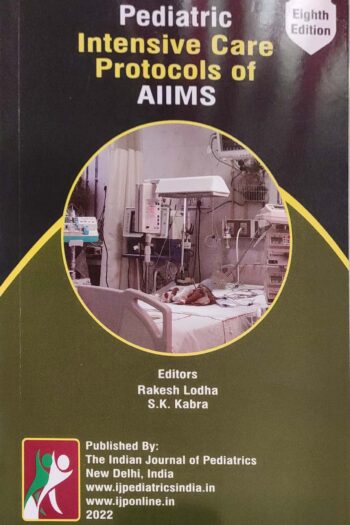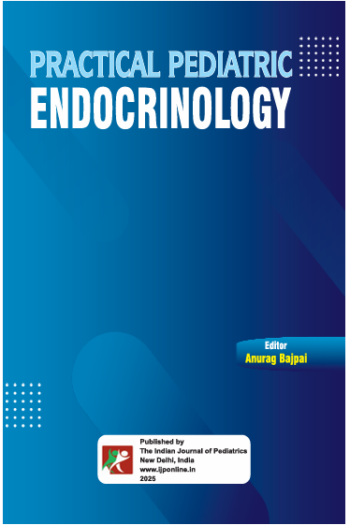Description
It gives us great pleasure to bring out the second edition of our book “Handbook of Neonatology” with a new title “Practical Neonatology”. The first edition was published 3 years ago, and it received favorable comments from practicing physicians and neonatal fellows in training. This gave us an impetus for the new and improved 2nd edition.
In India, the government has initiated many programs directed towards the welfare of the mother, newborn and child which has resulted in dramatic improvement in the availability of neonatal care facilities at district and sub district level. The main goal is to bring down Stillbirth Rate (SBR) and Neonatal Mortality Rate (NMR) to single digits by 2030. This is a commendable goal but requires continuous efforts to educate and train health care workers. The facilities also need better technology and laboratory support.
Neonatal care is constantly improving/changing not just in the west but across the globe because of technological advances, deeper understanding of physiology and molecular biology. Our goal is to provide clear, current and concise information to the vast number of practicing neonatologists, physicians in training, medical students and nursing staff not only in India but also in other developing countries. All the authors in the first and current edition are senior and experienced neonatologists, cardiologists, obstetricians/perinatologists, pediatric surgeons with vast clinical and research experience. The first edition contained all 119 chapters in one volume and included both the care of normal newborn and sick newborn. The book was bulky for a quick bedside reference hence we sought the expertise of senior editor Prof.I C Verma and publishers to improve upon the format of the book and chapter presentation. After considerable discussion we agreed to bring out the book in two volumes and change the title to Practical Neonatology -Volume-1 and Volume -2.
Volume 1 contains chapters pertaining to Prenatal assessment, Prenatal diagnosis, Genetic counselling, Delivery room care including Resuscitation, Assessment of Newborn, Nutrition, Hyperbilirubinemia, Metabolic Disorders, Neonatal Infections, Neonatal Dermatology and Neonatal procedures.
Volume 2 deals with clinical management of sick newborn with respiratory disorders, cardiac anomalies, Surgical Conditions, Renal and Hematological disorders, Neurological and neuroimaging issues, Pain management, Ethical issues and Discharging high risk infants from NICU.The second volume also includes chapters like Quality improvement in the NICU, Managing medical equipment, Dose and administration of drugs in neonate, Normal laboratory values in neonates, all important in the developing countries.
In this second edition readers will also appreciate the improved format with colorful titles, subtitles, and clear figures and tables for easy reference. Editors are pleased to bring this edition to you and hope this will help all the readers in everyday care of normal and sick newborns.We welcome any feedback positive or negative from the readers so that we can improve the content in the next edition.
We want to express our special gratitude to our senior editor Prof.I C Verma and the editorial staff at IJP for their timely help during the difficult pandemic times.
Contents (For any queries, please call us at 9810290145 or email at ijpsub@gmail.com)
| SECTION II: FETAL ASSESSMENT | ||
| Chapter 1. | The Evolution of Modern Neonatal-Perinatal Medicine — A Brief Timeline |
3–8 |
| Chapter 2. | Identification of High Risk Pregnancy and Counseling |
11–22 |
| Chapter 3. | Prenatal Diagnosis |
23–29 |
| Chapter 4. | Antenatal Genetic Counseling |
30–37 |
| Chapter 5. | Multiple Pregnancy |
38–44 |
| Chapter 6. | Antenatal and Postnatal Corticosteroid Administration |
45–50 |
| SECTION III: DELIVERY ROOM CARE | ||
| Chapter 7. | Transition to Extrauterine Life |
53–58 |
| Chapter 8. | Resuscitation and Stabilization of the Newborn Infant |
59–71 |
| SECTION IV: ASSESSEMENT OF THE NEWBORN | ||
| Chapter 9. | Examination of the Newborn |
75–82 |
| Chapter 10. | Intrauterine Growth Restriction (IUGR) |
83–89 |
| Chapter 11. | Preterm and Late Preterm Infants and their Problems |
90–97 |
| Chapter 12. | Infant of Diabetic Mother |
98–102 |
| Chapter 13. | Birth Injuries |
103–107 |
| Chapter 14. | Levels of Neonatal Care |
108–112 |
| SECTION V: THERMOREGULATION | ||
| Chapter 15. | Thermoregulation in Delivery Room |
115–119 |
| Chapter 16. | Kangaroo Mother Care |
120–125 |
SECTION VI: TRANSPORT OF THE NEWBORN
Chapter 17. Stabilization and Transport of Sick Neonate 129–138
SECTION VII: NUTRITION OF THE NEWBORN
| Chapter 18. | Breastfeeding |
141–145 |
| Chapter 19. | Formula Feeding |
146–148 |
| Chapter 20. | Nasogastric and Nasojejunal Feeding |
149–154 |
| Chapter 21. Chapter 22. Chapter 23. |
Feeding Problems of Preterm Infants Feeding Infants with Cleft Lip and Palate Parenteral Nutrition |
155–158 159–164 165–173 |
| SECTION VIII: NEONATAL HYPERBILIRUBINEMIA | ||
| Chapter 24. | Neonatal Jaundice — Hemolytic |
177–182 |
| Chapter 25. | Neonatal Jaundice — Non-Hemolytic |
183–191 |
| SECTION IX: METABOLIC DISORDERS | ||
| Chapter 26. | Glucose Homeostasis in the Newborn and Neonatal Hypoglycemia |
195–202 |
| Chapter 27. | Calcium Homeostasis in the Newborn: Management of Hypocalcemia and Hypercalcemia |
203–209 |
| SECTION X: NEONATAL INFECTIONS | ||
| Chapter 28. | Neonatal Bacterial Sepsis |
213–221 |
| Chapter 29. | Neonatal Viral Infections |
222–228 |
| Chapter 30. | Neonatal Candida Infections |
229–234 |
| Chapter 31. | Human Immunodeficiency Virus Infection |
235–242 |
| Chapter 32. | TORCH Infections in the Neonate |
243–258 |
| Chapter 33. | Infection Control and Surveillance in Neonatal Intensive Care Unit |
259–263 |
| SECTION XI: NEONATAL DERMATOLOGY | ||
| Chapter 34. | Evaluation and Management of Neonatal Skin Conditions |
267–280 |
| Chapter 35. | Neonatal Skin Care |
281–285 |
| SECTION XII: NEONATAL PROCEDURES | ||
| Chapter 36. | UAC/UVC/Radial Artery Catheterization |
289–295 |
| Chapter 37. | Peripheral Vein Cannulation for Intravenous Catheter Placement |
296–299 |
| Chapter 38. | Percutaneous Central Line Placement |
300–307 |
| Chapter 39. | Peripheral Blood Sampling |
308–310 |
| Chapter 40. | Lumbar Puncture/ Spinal Tap |
311–313 |
| Chapter 41. | Abdominal Paracentesis |
314–315 |
| Chapter 42. | Pleurocentesis and Chest Tube Placement |
316–321 |
| Chapter 43. | Pericardiocentesis |
322–325 |
| Chapter 44. | Peritoneal Dialysis and Other Renal Replacement Therapies in Neonates |
326–331 |
| Chapter 45. Index |
Exchange Transfusion | 332–336 337–339 |
SECTION XIII: RESPIRATORY DISORDERS
| Chapter 46. | Respiratory Distress Syndrome |
343–349 |
| Chapter 47. | Transient Tachypnea of the Newborn |
350–353 |
| Chapter 48. | Apnea of Prematurity |
354–358 |
| Chapter 49. | Meconium Aspiration Syndrome |
359–364 |
| Chapter 50. | Persistent Pulmonary Hypertension of the Newborn |
365–376 |
| Chapter 51. | Airleak Syndrome in Neonates |
377–382 |
| Chapter 52. | Pleural Effusion and Chylothorax in Neonates |
383–387 |
| Chapter 53. | Pulmonary Hemorrhage in Newborn |
388–391 |
| SECTION XIV. RESPIRATORY CARE OF THE NEWBORN | ||
| Chapter 54. | Oxygen Therapy and Pulse Oximetry |
395–400 |
| Chapter 55. | Non-Invasive Ventilation: CPAP, HHHFNC and NIPPV |
401–408 |
| Chapter 56. | Invasive Ventilation in Newborns |
409–418 |
| Chapter 57. | Bronchopulmonary Dysplasia |
419–424 |
| Chapter 58. | Neonatal ECMO |
425–433 |
| Chapter 59. | Interpretation of the Blood Gas |
434–442 |
| Chapter 60. | Interpreting Chest X-rays in Neonates |
443–448 |
| SECTION XV. CARDIOVASCULAR DISORDERS | ||
| Chapter 61. | Shock in Neonates |
451–458 |
| Chapter 62. | Patent Ductus Arteriosus in Preterm Infants |
459–465 |
| Chapter 63. | Congenital Heart Diseases: Cyanotic Disorders |
466–475 |
| Chapter 64. | Congenital Heart Diseases: Acyanotic Disorders |
476–485 |
| Chapter 65. | Managing Neonates After Cardiac Surgery — Neonatal Cardiac Intensive Care |
486–494 |
| SECTION XVI. GASTROINTESTINAL DISORDERS | ||
| Chapter 66. | Maturation of Gastrointestinal Motility |
497–499 |
| Chapter 67. | Gastroesophageal Reflux Disease in Infants |
500–503 |
| Chapter 68. | Neonatal Necrotizing Enterocolitis |
504–509 |
| Chapter 69. | Probiotics in the Neonatal Intensive Care Unit |
510–514 |
| Chapter 70. | Neonatal Cholestasis — An Overview |
515–521 |
| SECTION XVII. HEMATOLOGICAL DISORDERS | ||
| Chapter 71. | Anemia in the Newborn |
525–530 |
| Chapter 72. | Polycythemia in the Newborn |
531–534 |
| Chapter 73. | Thrombocytopenia |
535–538 |
| Chapter 74. | Thrombosis in the Newborn |
539–542 |
| Chapter 75. Chapter 76. |
Bleeding in the Newborn Transfusions in the Newborn |
543–548 549–552 |
| SECTION XVIII. RENAL DISORDERS | ||
| Chapter 77. | Renal Functions in Newborn |
555–563 |
| Chapter 78. | Acute Kidney Injury in Neonates (AKIN) |
564–570 |
| Chapter 79. | Hypotension in the Newborn |
571–577 |
| Chapter 80. | Neonatal Hypertension |
578–583 |
| Chapter 81. | Genitourinary Anomalies in the Newborn |
584–592 |
| Chapter 82. | Neonatal Fluid and Electrolyte Management |
593–599 |
| SECTION XIX. NEUROLOGY | ||
| Chapter 83. | Recognition and Management of Hypoxic Ischemic Encephalopathy |
603–608 |
| Chapter 84. | Indian Experience with Therapeutic Hypothermia for Perinatal Asphyxia |
609–613 |
| Chapter 85. | Neonatal Seizures |
614–619 |
| Chapter 86. | Ischemic Perinatal Stroke |
620–627 |
| Chapter 87. | Intraventricular Hemorrhage in Premature Infants |
628–631 |
| Chapter 88. | White Matter Injury in Newborns |
632–635 |
| Chapter 89. | Neonatal Hydrocephalus |
636–641 |
| Chapter 90. | Neonatal Neuro-ICU and Non-Invasive Monitoring of Brain Function |
642–647 |
| Chapter 91. | Neonatal Hypotonia and Hypertonia |
648–652 |
| SECTION XX. NEUROIMAGING | ||
| Chapter 92. | Head Ultrasound |
655–660 |
| Chapter 93. | Computed Tomography (CT) |
661–665 |
| Chapter 94. | Magnetic Resonance Imaging (MRI) |
666–673 |
| SECTION XXI. NEONATAL OPHTHALMOLOGY | ||
| Chapter 95. | Common Neonatal Eye Problems |
677–684 |
| Chapter 96. | Retinopathy of Prematurity (ROP) |
685–690 |
| SECTION XXII. GENETIC DISORDERS | ||
| Chapter 97. | Newborn Screening |
693–699 |
| Chapter 98. | Chromosomal Anomalies |
700–711 |
| Chapter 99. | Inborn Errors of Metabolism |
712–722 |
| Chapter 100. | Genetic Counseling |
723–729 |
| SECTION XXIII. SURGICAL EMERGENCIES | ||
| Chapter 101. | Esophageal Atresia with Tracheo-esophageal Fistula — Diagnosis and |
733–735 |
|
Chapter 102. |
Management Neonatal Abdominal Wall Defects — Gastroschisis and Omphalocele |
736–741 |
| Chapter 103. | Neonatal Gastrointestinal Obstruction |
742–750 |
| Chapter 104. | Congenital Diaphragmatic Hernia |
751–756 |
| Chapter 105. | Abdominal Masses in the Newborn |
757–767 |
| Chapter 106. | Surgical Causes of Respiratory Distress in Neonates |
768–779 |
| Chapter 107. | Myelomeningocele |
780–784 |
| SECTION XXIV. PAIN MANAGEMENT | ||
| Chapter 108. | Pain Perception and Pain Assessment in Newborn Infants |
787–791 |
| Chapter 109. | Pain Management in Newborn Infants |
792–800 |
| SECTION XXV. NEONATAL ETHICAL ISSUES | ||
| Chapter 110. | Postpartum Depression — Diagnosis, Management and the Role of Pediatrician |
803–809 |
| Chapter 111. | Ethics in Perinatal/Neonatal Medicine |
810–814 |
| SECTION XXVI. DISCHARGING THE HIGH RISK INFANT | ||
| Chapter 112. | Discharge Planning of Preterm Newborn |
817–819 |
| Chapter 113. | Hearing Screening |
820–825 |
| Chapter 114. | Immunization in Neonatal Intensive Care Unit |
826–830 |
| Chapter 115. | Follow-up of High Risk Infants |
831–839 |
| SECTION XXVII. GENERAL TOPICS | ||
| Chapter 116. | Quality Improvement in the NICU |
843–846 |
| Chapter 117. | Managing Medical Equipment |
847–854 |
| Chapter 118. | Dose and Administration of Drugs in Neonates |
855–875 |
| Chapter 119. Index |
Normal Laboratory Values in Neonates | 876–884 885–888 |




Reviews
There are no reviews yet.